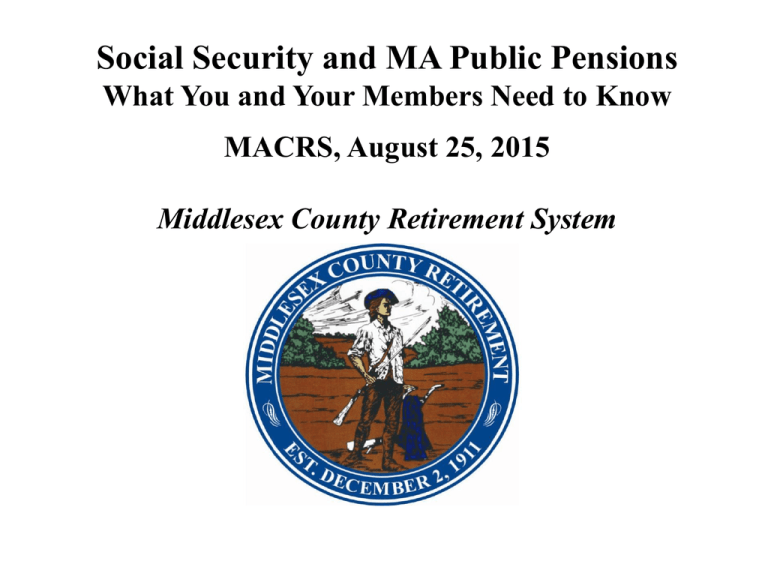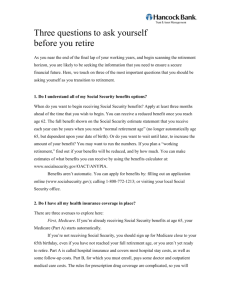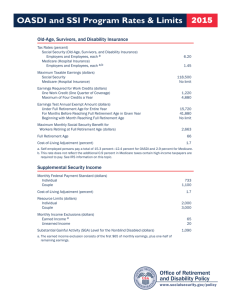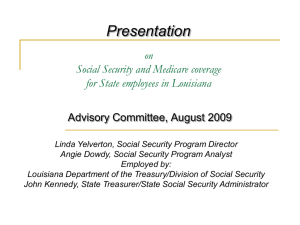Social Security and MA Public Pensions
advertisement

Social Security and MA Public Pensions What You and Your Members Need to Know MACRS, August 25, 2015 Middlesex County Retirement System What Board Administrators Need to Know • • • • The “basics” of Social Security An understanding of “WEP” An understanding of “GPO” The basic rules of Medicare • How to best advise your members about these issues What Members Need to Know • Are they eligible for Social Security on their own? • Are they eligible as a “spouse”? • Will they be subject to “WEP” or “GPO”? • When should they apply for benefits? • When should they apply for Medicare? The Social Security “Basics” For everyone there are 3 core elements for Social Security retirement: 1. VESTING 2. CALCULATING 3. THE 100% “FULL RETIREMENT AGE” How Do You Qualify for Social Security Retirement Benefits? • You need to work to earn Social Security “credits” to be vested. • Each $1,220 in earnings gives you one credit. • You can earn a maximum of 4 credits per year. • Example: To earn 4 credits in 2015, you must earn at least $4,880. • Earning 40 credits (10 years of work) throughout your working life will qualify you for a retirement benefit. How Social Security Determines Your Benefit Social Security benefits are based on earnings • Step 1: Your wages are adjusted for changes in wage levels over time • Step 2: Find the monthly average of your 35 highest earnings years • Step 3: Result is “average indexed monthly earnings” Full Retirement Age Year of Birth Full Retirement Age 1937 or earlier 1938 1939 1940 1941 1942 1943 – 1954 1955 1956 1957 1958 1959 1960 or later 65 65 & 2 months 65 & 4 months 65 & 6 months 65 & 8 months 65 & 10 months 66 66 & 2 months 66 & 4 months 66 & 6 months 66 & 8 months 66 & 10 months 67 Social Security Benefits May be Adjusted When… • A public employee in MA retires and begins to receive a public pension. • A public employee in MA retires and begins to receive an “annuity” as his or her primary payout, i.e., 457 plans. These are called “non-covered” pensions because public employees/employers did not pay into Social Security. Private sector employment contributes to Social Security. “Windfall Elimination Provision” Applies to those who receive a “non-covered” pension and are also vested for their own Social Security retirement benefit. Applies only to one’s own Social Security retirement benefit. The “Windfall” provision pays a lower retirement benefit, but will never eliminate their benefit. The “Windfall” 100% benefit can never be reduced by more than ½ your non-covered pension amount. (The maximum reduction for 2015 is $413.) Exceptions to the “Windfall” • Age 62 by 1/86 • “Eligible” for non-covered pension by 1/86 • 30 years of what Social Security considers “substantial earnings” If none of these exceptions apply, the “WEP” formula will be imposed and you will receive a lower Social Security payment What are “Substantial Earnings”? • Social Security has determined an exact dollar amount to be “substantial” for each calendar year – if you earned at least that amount or more in that year, you have a “substantial earnings year”. • If you total 30 or more of these years, your Social Security benefit will not be affected. • If you have 21-29 of these years, your retirement benefit is not lowered as much. “Substantial Earnings” ‘37-54 ‘55-58 ‘59-65 ‘66-67 ‘68-71 1972 1973 1974 1975 1976 1977 1978 $900 $1,050 $1,200 $1,650 $1,950 $2,250 $2,700 $3,300 $3,525 $3,825 $4,125 $4,425 1979 1980 1981 1982 1983 1984 1985 1986 1987 1988 1989 1990 $4,720 $5,100 $5,550 $6,075 $6,675 $7,050 $7,425 $7,875 $8,175 $8,400 $8,925 $9,525 “Substantial Earnings” (cont.) 1991 1992 1993 1994 1995 1996 1997 1998 1999 2000 2001 2002 $9,900 $10,350 $10,725 $11,250 $11,325 $11,625 $12,150 $12,675 $13,425 $14,175 $14,925 $15,750 2003 2004 2005 2006 2007 2008 ‘09-’11 2012 2013 2014 2015 $16,125 $16,275 $16,725 $17,475 $18,150 $18,975 $19,800 $20,475 $21,075 $21,750 $22,050 “Government Pension Offset” • Applies to individuals who qualify for spousal benefits on a living or deceased worker and receive a non-covered pension. • “GPO” chips away the spousal benefit and may chip it away to zero. • The “offset” only affects the Social Security benefit. Who Qualifies as a Spouse for Life Benefits? • • • • At least 62 years of age Currently married to the worker Divorced from worker and not remarried and must meet a 10 year duration of marriage (from date of marriage to date of final divorce decree) Who Qualifies for Spousal Benefits on a Deceased Worker? • Widows and widowers at least age 60 who have not remarried • Remarried widows and widowers who remarry after age 60 • Divorced widows/widowers who are not remarried and meet the duration of marriage prior to divorce How “GPO” Works 2/3 of the non-covered monthly pension amount is subtracted from the Social Security spousal benefit Example: • Public pension is $1200/month • 2/3 of $1200 is $800 • Assume SS spousal benefit is $750 • Then, no spousal benefits are due from Social Security. Rule: If 2/3 of the public pension is more than the Social Security spousal benefit, the spouse will get nothing. When “WEP” and “GPO” Will Not Apply • These provisions ONLY APPLY when the noncovered pension is being received. • Until someone begins to draw the noncovered pension, Social Security does not adjust the benefits! You Can Work & Still Receive Benefits Under Full Retirement Age Year $15,720/yr. ($1,310/mo.) $1 for every $2 earned will be withheld from benefits payable, if the earnings limit is exceeded. The Year Full Retirement Age is Reached $ 41,880/yr. ($3,490/mo.) $1 for every $3 will be withheld from benefits payable, if the earnings limit is exceeded. From the month of Full Retirement Age there is no earnings limitation. How to Determine Your WEP/GPO Benefit 1. Go to socialsecurity.gov 2. Go to “Benefits” on the toolbar 3. Click on “Government Employees” 4. Click “Windfall Calculator” 5. Click “Govt. Pension Offset Calculator” Open a “my Social Security Account” • Provide some personal information to verify your identity. • Choose a username and password to create your account. • Go to socialsecurity.gov my Social Security Services Before you receive benefits you can: • Verify your lifetime earnings according to Social Security’s records • Review the estimated Social Security and Medicare taxes you’ve paid • View, save, and print your Social Security Statement* • Learn about qualifying and sign up for Medicare *The Social Security retirement amounts in the“Statement” may not be accurate!!!! my Social Security Services If you do get benefits you can: • Check your benefit and payment information and verify your earnings record • Change your address and phone number • Start or change your direct deposit Your Age at the Time You Elect Retirement Benefits Affects the Amount If you are a Worker and Retire on your own Social Security: • At the earliest age, 62, you get a reduced monthly payment. • At your full retirement age, you get your 100% benefit. • Delaying benefits beyond full retirement age, whether working or not, will increase the full 100% (8%/yr. until age 70). Benefits for Surviving Spouses • At full retirement age, 100% of deceased worker’s benefit • At age 60, 71.5% of deceased worker’s unreduced benefit is payable • Filing option- reduced benefits on one record at age 60, reduced or unreduced benefit on other record at age 62 or older • Benefits apply to both widow or widower and divorced widow or widower. Medicare Coverage • Part A - Hospital Insurance • Covers most inpatient hospital expenses • 2015 Deductible $1,260 • • • • • Part B - Medical Insurance Covers 80% doctor bills & other outpatient medical expenses after 1st $147 in approved charges 2015 Standard Monthly Premium $104.90 Who is Eligible for Free Part A? • Individuals with 40 credits under Social Security • Individuals who do not have 40 credits but are a spouse, ex-spouse, widow/widower of a worker who has 40 credits • “Non-covered” employees who paid into Medicare only for 10 years (1.45% of F.I.C.A. taxes) ** Anyone can purchase Part B! There Are 3 Enrollment Periods • INITIAL ENROLLMENT • SPECIAL ENROLLMENT • GENERAL ENROLLMENT Initial Enrollment Period • This is your “age 65 window.” • File 3 months prior to your 65th birthday month to be effective the first day of the month you turn 65. • This applies to those not working with an active employer plan at 65 and/or those not covered under a spouse’s active plan at 65. Special Enrollment Period • An “active” employee or spouse of an employee • covered by employer group health plan will • remain on the employer plan as “primary” beyond age 65, in most cases. • This enrollment does not hold a penalty for filing after age 65. • There is no lapse in coverage from “active” to “retiree” status Special Enrollment Period (cont.) • The employer is asked to complete a form (L564) to verify the active coverage dates. The individual signs a Part B enrollment form (HCFA 40B) • Part B should be initiated 2-3 months before the date of change from active to retiree so that coverage will be in place timely. **If you are not on Part A at the time of retirement, you will need to file for both Parts A and B by completing a full application with SSA. General Enrollment Period • A “GEP” occurs each Jan. through March for individuals who missed an initial or special enrollment. The coverage begins July 1st of the year of enrollment. • A penalty of 10% is imposed for each year the person should have applied for Part B, but did not. • The penalty is added to the base premium for that year and remains for life! What If…? I retired from MA public service before age 65 and carry my health insurance as a retiree. I am approaching age 65… • You must file for both Part A and B within 3 months of your 65th birthday month. Medicare is effective on the 1st day of the month you turn 65. • You’ll be billed quarterly until you begin to receive Social Security payments. • If you are already collecting SS when you are 65, Medicare is automatic and Social Security will notify you about 4 months before your 65th birthday! What if…? I am approaching age 65 and will continue to work beyond age 65 and have coverage under an employer group plan… • Your active plan is primary and Medicare is not needed until you retire. • If you do nothing with Medicare, you will not be penalized. You can (but are not required) to sign up for Part A only. It will not interfere with your active coverage. • Your employer will verify your active coverage when you retire and apply for Medicare. • This applies to spouses covered under the active plan. What if I’m over 65, my active plan is ending and…? I have Part A only: About 3 months before you or your spouse retires, request the “Special Enrollment” forms from Social Security. I never signed up for Part A or Part B: You must complete an application for Medicare. File it online in 8 minutes or less or call Social Security and make a phone appointment to file for A and B. Filing 2-3 months before retirement will effectuate Medicare the first month of retiree status and there will be no lapse in coverage and no penalty. Things to Remember • File for retirement benefits about 3 months before you want to begin collecting. • If you are already retired from public service and are not yet receiving Social Security benefits, file for Medicare Parts A and B three months before your 65th birthday. • If you work past “full retirement age”, you must contact your local SS office about 3 months before you retire to provide proof of your public pension and apply for Part A and/or Part B. More Things to Remember • Web pages for “WEP” and “GPO”: http://www. socialsecurity.gov/planners/retire/gpo-wep.html • Web page for GPO reporting form (ssa-3885): Socialsecurity.gov/forms/ssa-3885pdf • Web pages for WEP reporting form (ssa-150): Socialsecurity.gov/forms/ssa-150pdf • Medicare Part B forms for working past age 65: HCFA 40B and L564: social security.gov/forms. Social Security’s Online Services www.socialsecurity.gov Online Services for before or after you receive benefits: • Social Security Statement • Change of Address and Phone Number • Get a Benefit Verification Letter • Start or Change Direct Deposit • Retirement Estimator • Retirement & Disability Applications • Medicare Online • Apply for Extra Help With Medicare Drug Plan Costs • Retirement/Survivors/Disability Planner • Medicare Card Replacements ???QUESTIONS??? Middlesex County Retirement System






